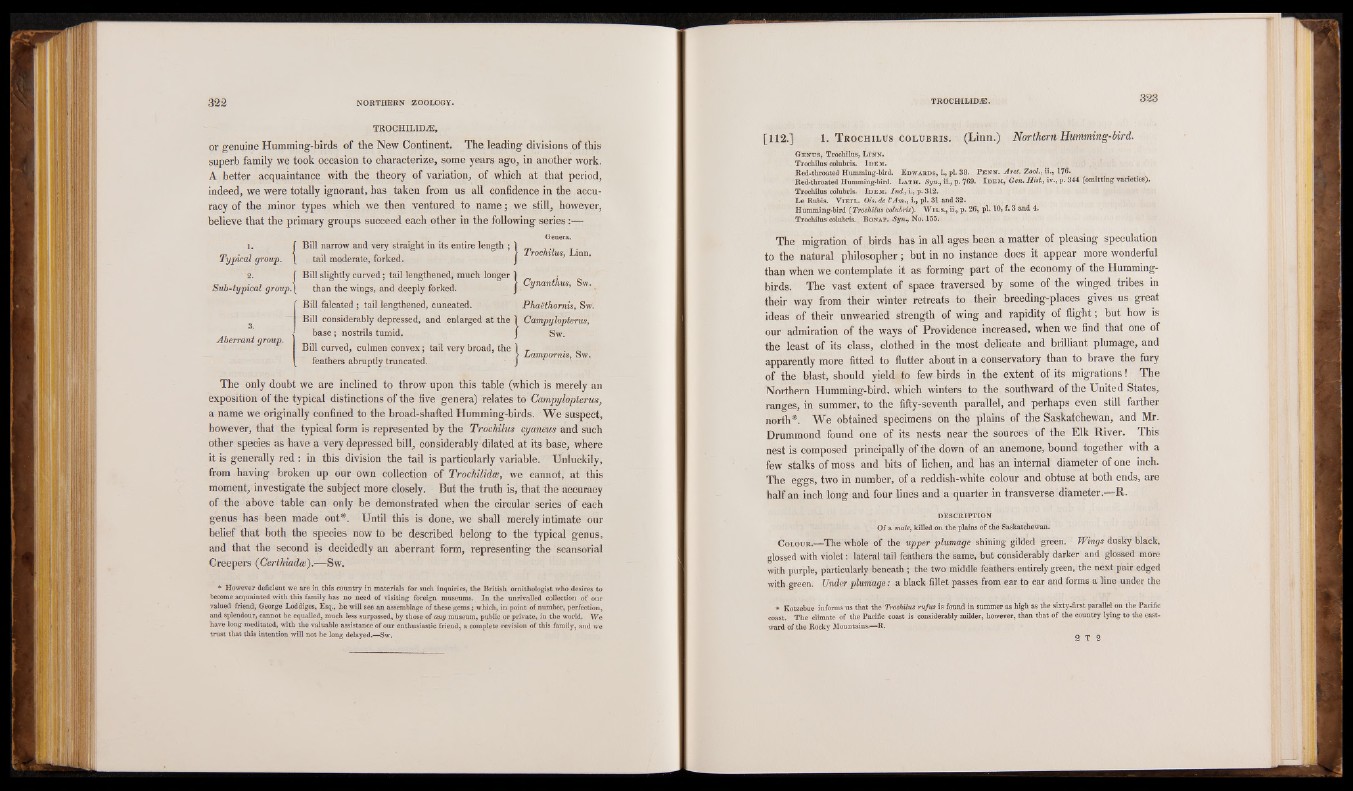
TROCHILID^,
or genuine Humming-birds of the New Continent. The leading divisions of this
superb family we took occasion to characterize, some years ago, in another work.
A better acquaintance with the theory of variation, of which at that period,
indeed, we were totally ignorant, has taken from us all confidence in the accuracy
of the minor types which we then ventured to name; we still, however,
believe that the primary groups succeed each other in the following series:—
Typical group. 1
2. Sub-typical group.
Bill narrow and very straight in its entire length ;
tail moderate, forked.
Bill slightly curved; tail lengthened, much longer
than the wings, and deeply forked.
Genera.
| Trochilus, Linn.
| Cynanthus, Sw.
3.
Aberrant group.
Bill falcated ; tail lengthened, cuneated.
'Bill considerably depressed, and enlarged at the
base; nostrils tumid.
Bill curved, culmen convex; tail very broad, the
feathers abruptly truncated.
Phaethornis, Sw.
Campylopterus,
Sw.
Lampornis, Sw.
The only doubt we are inclined to throw upon this table (which is merely an
exposition of the typical distinctions of the five genera) relates to Campylopterus,
a name we originally confined to the broad-shafted Humming-birds. We suspect,
however, that the typical form is represented by the Trochilus cyaneus and such
other species as have a very depressed bill, considerably dilated at its base, where
it is generally red : in this division the tail is particularly variable. Unluckily,
from having broken up our own collection of Trochilidce, we cannot, at this
moment, investigate the subject more closely. But the truth is, that the accuracy
of the above table can only be demonstrated when the circular series of each
genus has been made out*. Until this is done, we shall merely intimate our
belief that both the species now to be described belong to the typical genus,
and that the second is decidedly an aberrant form, representing the scansorial
Creepers (Certhiadce).—Sw.
* However deficient we are in this country in materials for such inquiries, the British ornithologist who desires to
become acquainted with this family has no need of visiting foreign museums. In the unrivalled collection of our
valued friend, George Loddiges, Esq,, he will see an assemblage of these gems; which, in point of number, perfection,
and splendour, cannot be equalled, much less surpassed, by those of any museum, public or private, in the world. We
have long meditated, with the valuable assistance of our enthusiastic friend, a complete revision of this family, and we
trust that this intention will not be long delayed.—Sw.
[112.] 1. T r o c h il u s c o l u b r is . (Linn.) Northern Humming-bird.
Genus, Trochilus, Lin n.
Trochilus colubris. I dem.
Red-throated Humming-bird. Edwards, i., pi. 38. Penn. Arot. Zool.: ii., 176.
Red-throated Humming-bird. Lath. Syn., ii., p. 769. I dem, Gen. Hist., iv., p. 344 (omitting varieties).
Trochilus colubris. Idem. Ind., i., p. 312.
Le Rubis. Vie il . Ois. de VAm., i., pi. 31 and 32.
Humming-bird ( Trochilus colubris). W ils., ii., p. 26, pi. 10, f. 3 and 4.
Trochilus colubris. B onap. Syn^ No; 155;
The migration of birds has in all ages been a matter of pleasing speculation
to the natural philosopher; but in no instance does it appear more wonderful
than when we contemplate it as forming part of the economy of the Hummingbirds.
The vast extent of space traversed by some of the winged tribes in
their way from their winter retreats to their breeding-places gives us great
ideas of their unwearied strength of wing and rapidity of flight; but how is
our admiration of the ways of Providence increased, when we find that one of
the least of its class, clothed in the most delicate and brilliant plumage, and
apparently more fitted to flutter about in a conservatory than to brave the fury
of the blast, should yield to few birds in the extent of its migrations! The
Northern Humming-bird, which winters to the southward of the United States,
ranges, in summer, to the fifty-seventh parallel, and perhaps even still farther
north*. We obtained specimens on the plains of the Saskatchewan, and Mr.
Drummond found one of its nests near the sources of the Elk River. This
nest is composed principally of the down of an anemone, bound together with a
few stalks of moss and bits of lichen, and has an internal diameter of one inch.
The eggs, two in number, of a reddish-white colour and obtuse at both ends, are
half an inch long and four lines and a quarter in transverse diameter.—R.
DESCRIPTION
Of a male, killed on the plains of the Saskatchewan.
C olour.— The whole of the upper plumage shining gilded green. Wings dusky black,
glossed with violet: lateral tail feathers the same, but considerably darker and glossed more
with purple, particularly beneath ; the two middle feathers entirely green, the next pair edged
with green. Under plumage: a black fillet passes from ear to ear and forms a line under the
* Kotzebue informs us that the Trochilus rufus is found in summer as high as the sixty-first parallel on the Pacific
coast. The climate of the Pacific coast is considerably milder, however, than that of the country lying to the eastward
of the Rocky Mountains.—R.